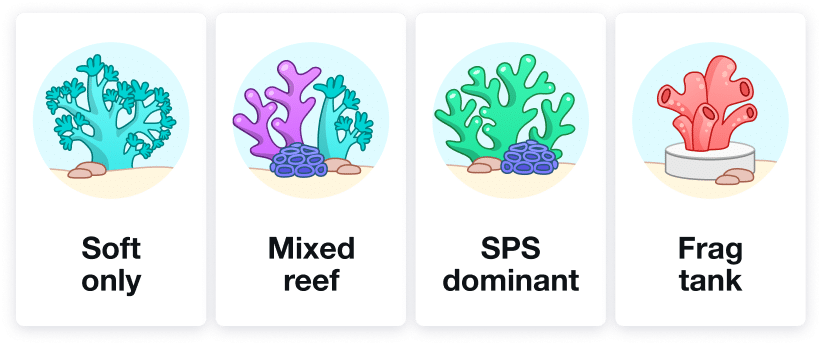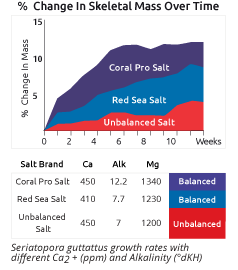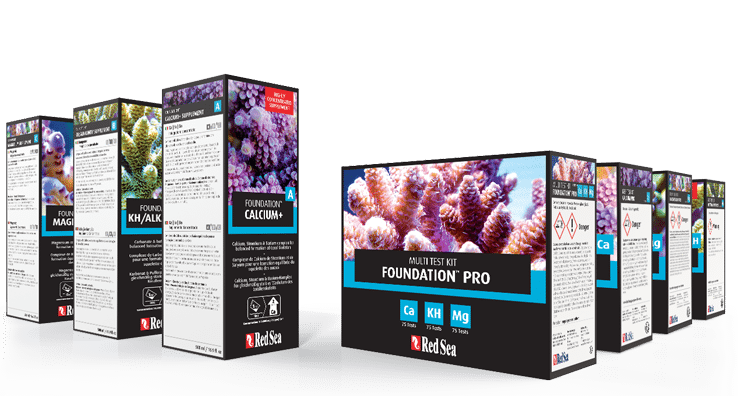Red Sea’s Foundation Elements – Maintaining a Reef Aquarium
A successful coral reef aquarium is dependent upon maintaining the appropriate water parameters that, in turn, provide the stable environment required by the corals.
Although all the elements found in natural seawater have an important role in providing the optimal water parameters, a few of them have a more significant role in the overall stability. These elements are the foundation of the reef environment and they include the three major elements: calcium (Ca), magnesium (Mg) and bicarbonates (HCO3).
These three reef foundation elements have a major effect on the water chemistry (pH stability, alkalinity and seawater ionic strength) and on many of the coral’s biological processes (skeleton formation, ions exchange, and photosynthesis).
Red Sea’s Foundation Elements provides a complete solution for maintaining and replenishing the foundation building blocks of the reef aquarium by providing complete and balanced supplements, formulated to work together for long term use and without changing the ionic balance of the water.
Optimal levels of the Reef Foundation Elements
Unlike the natural reef environment, where there is an immense reservoir of the foundation elements, the reef aquarium is an artificial environment that is constantly affected by chemical changes. Therefore, the reef foundation elements must be monitored and replenished constantly.
Research has also shown that the optimal levels of these elements should be maintained according to the variety and maturity of the specific coral population. In order to accurately select the optimal level for your reef aquarium system, it is best to use the values for the most demanding coral species in your marine aquarium.
How much to supplement?
To easily achieve your reefing goals check out our new MyRecipe™ Wizard, which recommends the optimal water parameters, supplementing program and premium salt that is best for you.
Implementing Red Sea’s Foundation Elements will maintain the required concentration of Foundation Elements, providing optimal conditions for enhancing coral calcification rates through increasing passive diffusion, while reducing the energetic demands on the coral caused by the need to pump the elements into the calcification centers. The end result is stronger, healthier and more colorful corals.
Coral Growth
Corals need to invest energy in transporting the foundation and other elements necessary for skeletogenisis from the surrounding water through their soft tissue.
Elevated levels of reef foundation elements create a more positive ionic pressure enabling passive diffusion of the elements through the soft tissue. This makes the process much more efficient (less energy required per gram of skeleton). Therefore, balanced elevated levels of foundation elements will result in accelerated coral growth rates.
In mature systems where accelerated growth is not desired or when aiming to enhance coral coloration by reducing the levels of algae nutrients, lower balanced levels of the reef foundation elements should be maintained.
Skeletogenesis

Skeletogenesis is the process by which special cells within the corals’ soft tissue combine the foundation elements together with strontium and barium from the surrounding water to form the building blocks of coral skeletons.
Corals build approximately 90% of their skeleton by combining calcium and carbonate ions from the water to form aragonite (CaCO3).
The rest of the skeleton is made up from magnesite (MgCO3), strontianite (SrCO3), calcite (a more brittle crystal structure of CaCO3), fluorite (CaF2) and other minor and trace minerals. In unbalanced conditions such as low levels of Mg and/or Sr the skeleton will develop with a higher proportion of calcite making it more brittle and more susceptible to damage.
The foundation elements complement each other in the formation of coral skeleton. If they are not available in the correct ratios, one of them will quickly become the limiting factor of healthy coral growth. source

